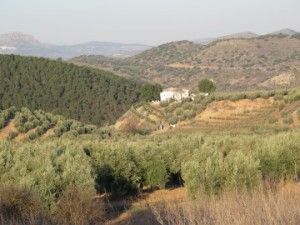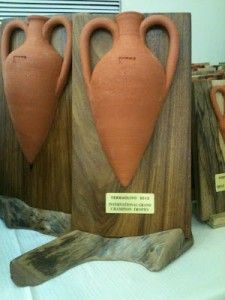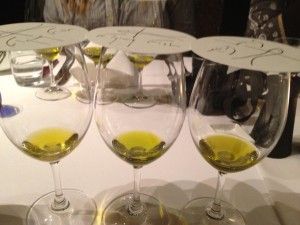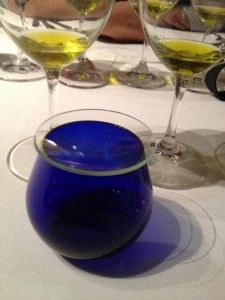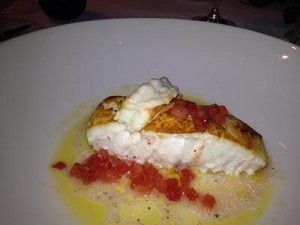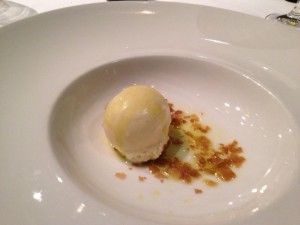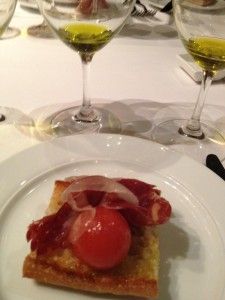How To Taste Liquid Gold
Which country is the world’s largest producer of olive oil? If you said Spain, you’re right.
But were you aware that if you planted all of Spain’s olive trees five metres apart, they would circle the world twenty one times?
It’s a staggering figure of almost 283 million trees, covering 2.5 million hectares. Spain produces 1.6 million metric tonnes of olive oil per year (or 52% of worldwide production (compared with Italy which produces 21%; Greece 23% and Turkey 11%); and it’s not just quantity which puts Spain at number one, it’s also quality (at TerraOlivo in Israel this year, the International Grand Champion Trophy went to Aroden SAT of Spain for their Cladivm Hojiblanca).
I learnt these astonishing facts at a dinner hosted by the Trade Commission of Spain with special guest speaker, the internationally renowned Spanish olive oil expert, Alfonso Fernandez, at Flying Fish restaurant, Pyrmont, last week.
The invitation was for an olive oil tasting followed by an exclusive dinner prepared with olive oils from Spain especially selected for the occasion.
Three wine glasses, each with a different variety of olive oil (Arbequina, Hojiblanca and Picual) had been set out in front of us to taste.
Formal tastings are conducted using 100ml blue tasting glasses specially designed with a cover as prescribed by the IOC (International Olive Oil Council).
“Unlike wine, colour plays no importance in the tasting of olive oil” he said. “And variety is more important than terroir when tasting olive oil.
“The best time to taste is early in the morning before breakfast”.
Here are some of his tips:
– Pour 25ml of the oil to be tasted into a numbered cup or glass.
– Place lid over glass to retain aroma.
– Warm tasting cup to approximately 36degC by cupping it in hands or placing on a warming pad.
– When ready to taste, remove oil and inhale, noting the aroma characteristics of the oil. “It must remind you of the vegetal world, and smell fresh and alive,” he said.
– Replace lid and record descriptions. Repeat, if necessary, to further define aroma.
– A balanced and harmonious oil is one in which fruit, bitterness and pepper are of equal intensity – without one overriding another.
The Arbequina smelled of ripe fruit and had a smooth, sweet flavour with a velvety texture. Some detected banana notes. A fresh oil, it combines perfectly with vegetables and grilled fish and is best used uncooked, since its aromatic substances are very volatile.
The Hojiblanca had a more intense aroma with slightly bitter or sharp notes and pepperiness at the back of the throat. Some detected a kiwi flavour. It’s a good one to use for frying, and is also ideal for making bread, pasta and pastries, due to the excellent consistency it gives to dough.
The Picual also had intense aroma and smelt of freshly crushed tomato leaves; it was well balanced in flavour with pepperiness at the back of the throat. Picaul is the most important variety, accounting for 50% of the production in Spain, and therefore about 20% of world production. It is best used in frying, although it is equally good for salads and gazpachos.
While these three are primary varieties, there are over 260 others including Cornicabra, Gordal, Manzanilla, Verdial de Badajoz and Lechin de Sevilla.
If you’d like to conduct your own olive oil tasting, why not purchase a few different varieties and judge for yourself. Choose the one that best suits your palate and adapt it to the meal you’re preparing.
At our dinner at Flying Fish, the Arbequina was drizzled over slices of kiwi fruit and blood orange; the Hojiblanca over pan con tomate with jamon; and the Picual was drizzled over a scoop of vanilla ice cream: just a few ideas which might inspire you to use olive oil in imaginative ways.
Next weekend, why not invite some friends over and ask each one to bring a different variety of olive oil with them. No need to worry about added entertainment – their differing opinions will provide that!

